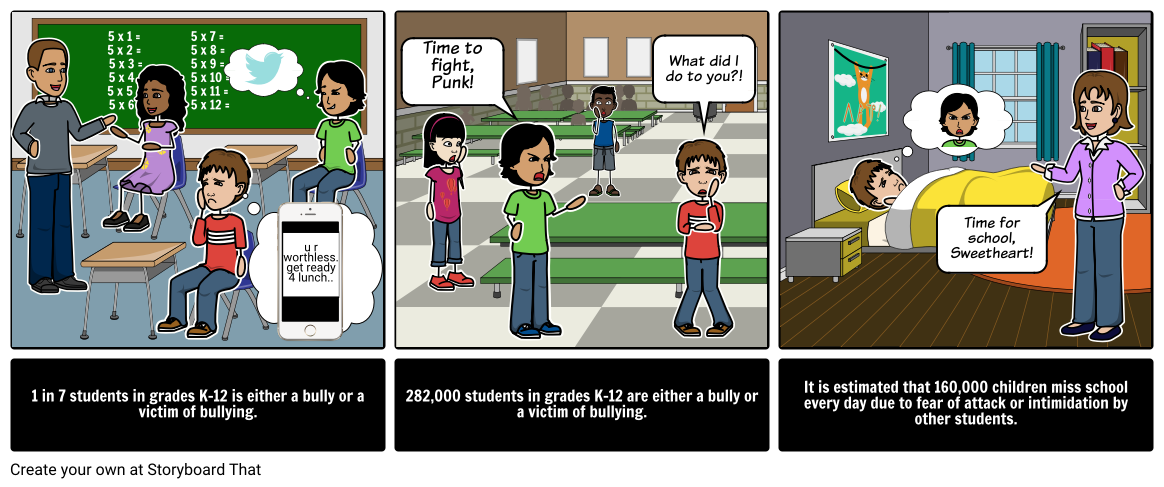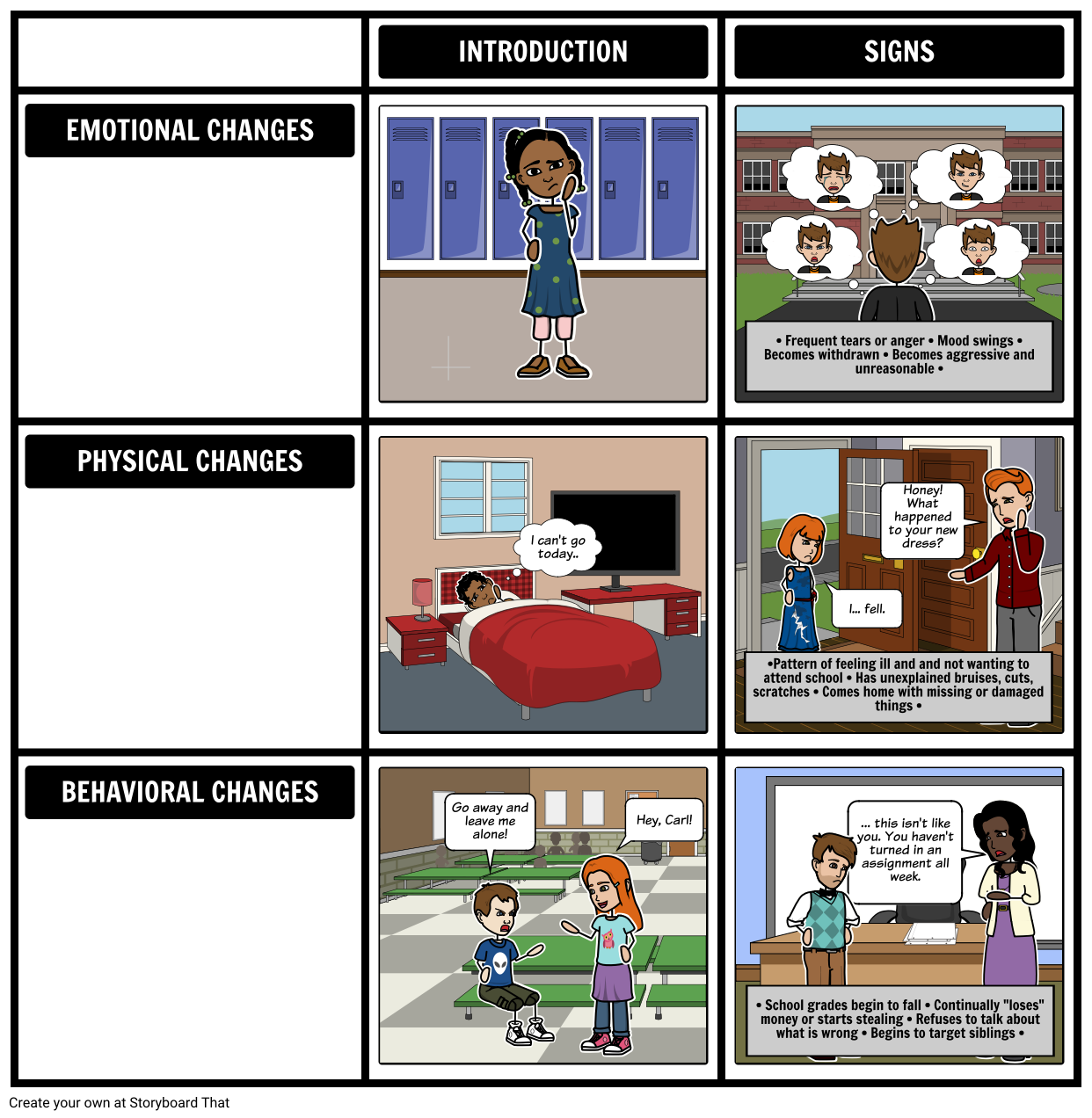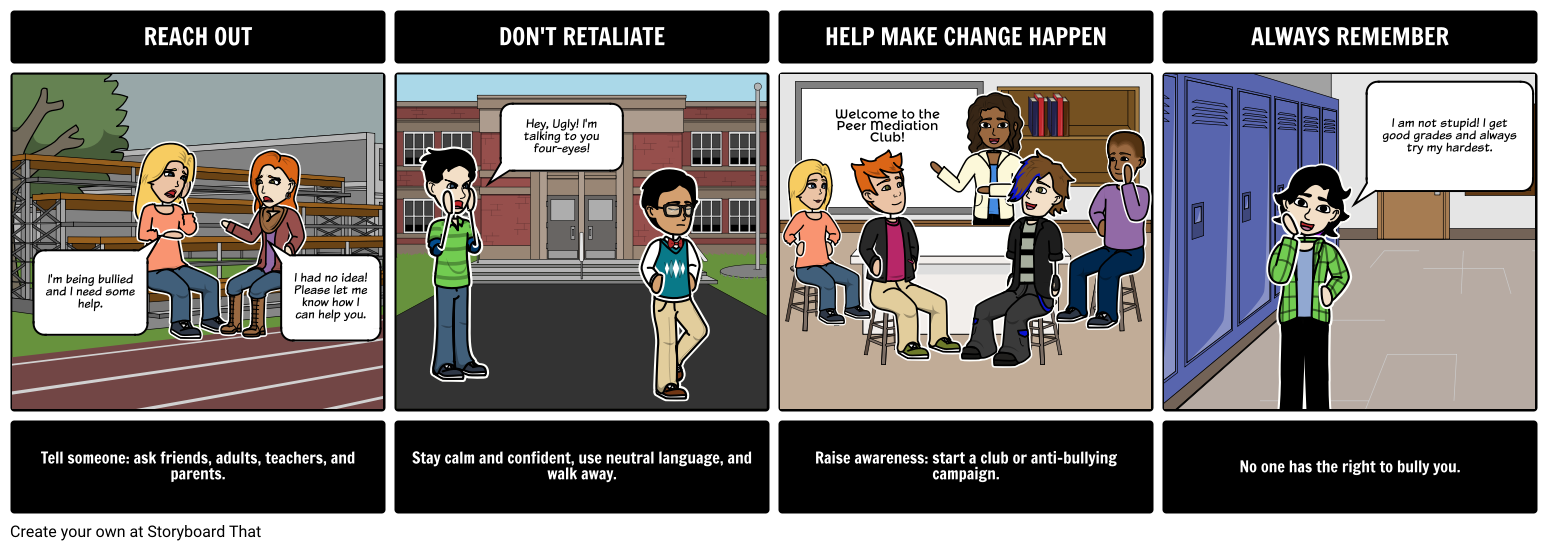In today’s school environment, students are facing new challenges. Besides keeping their grades up, balancing extracurriculars with home and social life, there are a growing number of students who are worried about being bullied.
Here at Storyboard That, we believe every student should have the right to a quality education, free of intimidation. We have found that by using storyboards to create role-playing scenarios, students can better see the effects and characteristics of bullying. Through interactive lessons, you can help change student mindsets from “bullying is a problem” to “bullying is a problem, and I can do something about it”.
Four Types of Bullying
Physical Bullying
Physical bullying includes person to person contact. Examples of this include shoving, tripping, kicking, and hitting. Sometimes this can be difficult to distinguish from rough play, but if it is at inappropriate times or if not everyone involved is comfortable, it may be bullying.
Verbal Bullying
Verbal bullying are words directed to a person. Name calling, insults, teasing, intimidation, or making homophobic or racist remarks are forms of verbal abuse.
Covert Bullying
”Covert bullying” refers to actions done behind a person’s back. It is done with the sole purpose of ruining a person’s reputation or causing humiliation. Examples of covert bullying include:
- Spreading rumors or generating lies about a person
- Making negative movements with body language
- Glaring at someone
- Playing jokes that embarrass and humiliate a person
- Mimicking someone in an unflattering way
- Convincing others to disassociate with someone
Cyberbullying
Cyberbullying can be either openly or secretly carried out. Cyberbullying uses technology and devices like social media, private websites, or mobile phones to deliberately target someone. Negative posts on social media and direct contact via text messaging are two of the most common forms of cyberbullying.
What Types of People are Bullied?
Bullying can happen to anyone. The most important thing for students to understand is that it isn’t their fault and they should tell someone if they or someone they know is being bullied.
Quick Bullying Statistics
Did you know that 80% of students online have encountered bullying online? For every five students online four of them have either been bullied, bullied someone else, or been a bystander observing the bullying.
The most common type of bullying is verbal bullying and it and affects 77% of students.
Signs That Someone is Being Bullied
Being bullied takes a huge impact on students and leads to seriously negative side effects. Students who are bullied can experience depression or anxiety, other mental health effects, physical health complications, and may suffer academically.
Here are some changes you might notice with a child who is being bullied.
| Emotional | Physical | Behavioral |
|---|---|---|
|
|
|
Addressing Bullying
If You See Someone Being Bullied
Bullying is not a victim-less crime, students should know their efforts can make a positive impact. If they see bullying they should stop it, and know they have the power to stand up to it. When someone close to them is being bullied, there are many steps to take to help resolve the situation. If they can help someone deal with bullying they will have done a wonderful act of kindness for a friend, acquaintance, or stranger. Here are some ways to help someone who is being affected by bullying.
4 Things You Can do if Someone is Being Bullied
- Listen: Let the person who has been bullied speak.
- Remind: Remind the person who has been bullied that it is not their fault, and they did not do anything to bring on this behavior.
- Get informed: Get and give advice, talk about ways to proceed, what steps you should take, and be sensible.
- Tell someone: Inform the school, or in extreme cases, call the police.
If You Are Being Bullied
If you are being bullied, you can take steps to improve your situation by reaching out to those you trust. The most important advice you should remember is that no one can make you feel a certain way only you have the choice how others affect you. Never lose hope or give up, life will get better!
4 Things You can do if You’re Being Bullied
- Reach out: Tell someone, ask friends, adults, teachers, and parents.
- Don’t Retaliate: Stay calm and confident, use neutral language, and walk away.
- Help Make Change Happen: Raise awareness, start a club or anti-bullying campaign.
- Remember: No one has the right to bully you!
If You Are a Child Who Bullies
If you are angry and take it out on others and don’t know why, there are ways to stop. If you are, or think you may be a child that bullies, speak to someone you trust and get help. Many times bullying is a result of not understanding the impact of our actions, here are ways to identify if you have bullied someone:
4 Ways to Tell if You Are a Child That Bullies
- Does it make you feel better when you hurt others or take things from them?
- Do you use your size and strength to get your way or take advantage of others?
- Have you been bullied by someone in the past and you take revenge on others because of it?
- Do you avoid thinking about people’s feelings, especially when you say or do hurtful things to them?
Teaching about Bullying
In a positive worldwide trend more and more countries are requiring that e-safety is taught in schools. In the US many states have adopted both laws and policies in anti-bullying efforts. For great tips and information visit https://www.stopbullying.gov.
4 Great Ways to Teach about Bullying, Tolerance, & E-Safety
- Use storyboards to depict “role play” activities of bullying. Use analogies and fables they can work from like, "The Three Little Pigs" or "Little Red Riding Hood".
- Bring in a Guest Speaker to your school!
- Teach using web tools such as Edutopia, BrainPOP, and Common Sense Media
- Through school-wide programs and clubs such as Peer Leadership, SADD, and GSA.
Related Activities
Additional Resources and Bibliography
- Bullying Education
- https://www.learningforjustice.org/magazine/antibullying-resources
- https://www.ncab.org.au/bullying-advice/bullying-for-kids/
- https://opa.hhs.gov/adolescent-health?news/e-updates/eupdate-7.html
- https://momlovesbest.com/bullying-prevention
How to Establish Anti-Bullying Policies and Procedures
Research And Familiarize Yourself
Research existing anti-bullying policies and procedures to gain a comprehensive understanding of best practices and legal requirements. Familiarize yourself with your school's specific needs, culture, and resources.
Collaborate And Involve Stakeholders
Engage school administrators, teachers, parents, students, and community members in the process of establishing anti-bullying policies and procedures. Encourage open dialogue, collect input, and address concerns to ensure a collaborative approach.
Define Bullying And Scope
Clearly define bullying, encompassing various forms (physical, verbal, online) and identifying specific behaviors that constitute bullying. Determine the scope of your anti-bullying policies, specifying applicable grade levels, locations, and circumstances.
Establish Reporting And Response Procedures
Develop clear reporting mechanisms for students, staff, and parents to report bullying incidents. Define a systematic and timely response process that includes investigating, documenting, and addressing reported incidents.
Outline Prevention And Intervention Strategies
Identify proactive prevention strategies, such as awareness campaigns, social-emotional learning programs, and conflict-resolution training. Define intervention strategies, including disciplinary measures, counseling resources, and restorative justice practices.
Communicate And Train
Clearly communicate the anti-bullying policies and procedures to all stakeholders, including students, parents, and staff. Provide comprehensive training and resources to teachers and staff on recognizing, responding to, and preventing bullying incidents.
Frequently Asked Questions about Types of Bullying
What are the four types of bullying?
The four main types of bullying are physical bullying, which involves person-to-person contact, verbal bullying, which includes the use of words to harm or intimidate, covert bullying, which is carried out behind someone's back with the aim of damaging their reputation, and cyberbullying, which uses technology to target someone.
What are some statistics on bullying?
According to recent studies, 80% of students have encountered bullying online, and 77% of students have experienced verbal bullying. Additionally, for every five students online, four of them have either been bullied, bullied someone else, or witnessed bullying as a bystander.
How can we teach about bullying, tolerance, and e-safety?
We can use storyboards, analogies, and fables, bring in guest speakers, utilize web tools such as Edutopia, BrainPOP, and Common Sense Media, and implement school-wide programs and clubs such as Peer Leadership, SADD, and GSA.
Introductory School Offer
ONLY$500
- 1 School
- 5 Teachers for One Year
- 1 Hour of Virtual PD
30 Day Money Back Guarantee • New Customers Only • Full Price After Introductory Offer • Access is for 1 Calendar Year
© 2025 - Clever Prototypes, LLC - All rights reserved.
StoryboardThat is a trademark of Clever Prototypes, LLC, and Registered in U.S. Patent and Trademark Office






















